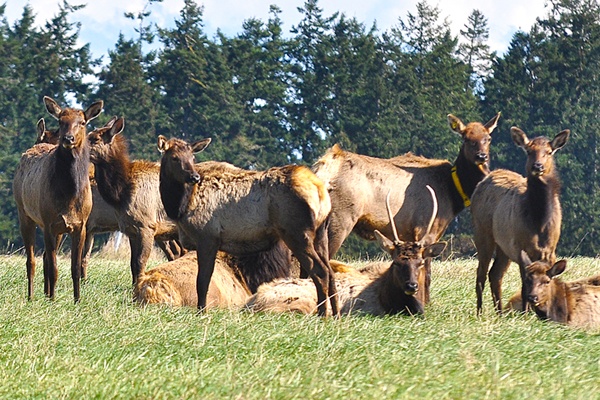The Sequim Gazette’s Facebook page has been enlivened in recent weeks with cries of concern over Sequim’s beloved herd of Roosevelt elk.
The “city,” wrote one commenter, “is planning to kill more of these beautiful creatures … there are only about 30 now.”
Well, yes and no.
The City of Sequim doesn’t have any control over the elk population — that responsibility falls to the Washington Department of Fish and Wildlife. In the past few months DFW has been culling the herd, bringing its numbers down from “about 40” to perhaps 20 to 25, said Sgt. Eric Anderson, an agency enforcement official.
Anderson, like many of his colleagues, is sensitive to rumors regarding the elk. “We understand how important the herd is to the city of Sequim,” he said. “We know some people are going to have some really strong feelings about this.”
“But,” he added, “we have to keep the herd at a number where we’re not having agricultural damage.”
He noted that that the elk population “isn’t stagnant.” Left unchecked the population would “grow exponentially.”
“They don’t have any natural predators,” Anderson said. “And they’re sitting there in some of the best fields in Washington.”
Sometimes, he said, they will make their home in a farmer’s field of corn for two or three months, putting on massive amounts of weight.
Those habits have been learned, said Jeff Skriletz, the acting regional permits program manager for Region Six, which includes the entire peninsula.
He noted that in the past the herd would spend a good deal of the year south of U.S. Highway 101. Now they prefer the areas north of 101 — especially the farms, which are natural draws.
Once there, Skriletz said, a herd can move through an agricultural field “like a hurricane.”
Or, he added, they may locate on a golf course, resulting in significant damage to the course.
Anderson said attempts to change their habits have largely failed. In some recent cases when the elk were moved to the Upper Dungeness, “they basically beat the trucks (that brought them) back to the farmers’ fields.”
Anderson said five or six years ago the department let the numbers grow to nearly 100, which resulted in “an incredible amount of agricultural damage.”
Moreover, he said, it resulted in a much larger than normal cull. “Almost 50 animals had to be harvested. That really gives the hunting community and the department a black eye,” he said.
Anderson added that 20 to 25 is a much more workable number, allowing for other options, including relocation to repopulate other areas. “You can’t do a capture and relocation when there are 40 to 60,” he said. “There are just too many of them.”
Reducing the population
The elk are culled through two different programs, with both focused on removing the animals that are causing the most damage.
Through the hunting season, which ends this Sunday, the department will call in “master hunters” in response to reports of crop damage. They target the animals “that are already doing damage” to agricultural fields.
Skriletz said killing an elk isn’t necessarily the first course of action. Often they can be chased off. And sometimes, he said, the master hunter will help a farmer repair fences.
But some number of them are likely to be killed, he said.
“If the damage stops, we stop sending them,” he said.
Farmers whose crops are being damaged can also apply for and receive a “damage permit” — an elk tag, essentially. This farmer can then either kill the elk or sell the permit to a licensed hunter.
Anderson said the sale of the permit can help the landowner recoup some of the losses caused by the elk. He estimated that a permit for an antlerless elk would fetch from $700 to $750. An “any animal” permit might go for $1,000 to $2,000.
Anderson estimated the current elk population on the peninsula at between 10,000 and 12,000. Most of those are found on private land, he said.
Reach Mark Couhig at mcouhig@sequimgazette.com.



